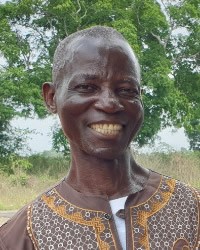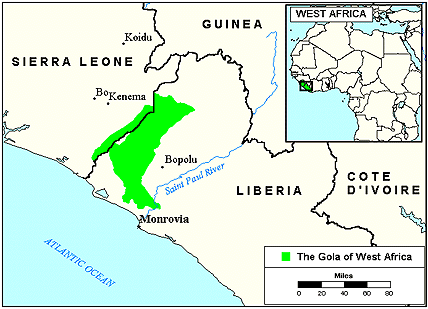Most of the Gola live in western Liberia, primarily in the districts of Lofa, Grand Cape Mount, Bomi, and Montserrando. Nearly nine thousand others live in the neighboring country of Sierra Leone, where they are concentrated in the small provinces of Kenema and Pujehun. The Gola speak a Niger-Congo language, also called Gola, that is closely related to the language of the Kissi.
Gola and Kissi migrations into western Liberia began as early as the 1300s, when they left their homes in Cote d'Ivoire and beyond. They moved to an area that was uninhabited and not suitable for farming. They have developed excellent farming methods; their land is now very productive.
Most are farmers, and they produce more than they consume. Transportation has improved since the 1950s allowing them to use good roadways for trade. Their mobility has allowed some of them to take to an urban environment.
Most Gola live in villages in round huts with thatched roofs. Their clans are like territorial units rather than kinship groups. Families work together for their abundant harvests. Men clear fields, women plant rice, yams, taro, peanuts and other crops. Women also harvest the crops while girls winnow the rice. Boys contribute by chasing birds from their fields.
Because farming plays such a large part of their lives the Gola religion revolves around agriculture. They must offer the first fruits to their gods and each year they celebrate their yam and peanut harvest. When there is a drought their village elders holds the skull of an elder and pray for rain to a god named Da. Then he sacrifices a chicken to Da and pours chicken blood over the skull.
Circumcision is an important rite for boys. They consider it a type of rebirth and a way to link their affiliation to the gods. He lives in seclusion for a month after being circumcised; during this time he cannot talk with anyone. When it's over he is given gifts, arrows and food. At this point the boy has the status of a responsible man, and he can join in their religious cults.
The Gola are mostly Muslim. Theirs is a religion of works based on five basic "pillars." Muslims must affirm that "there is no god but Allah, and Mohammed is his prophet." They are also required to pray five times a day, give alms to the poor, fast during the month of Ramadan, and try to make at least one pilgrimage to Mecca.
Over one-fifth of the Gola still adhere to their traditional religious or animistic beliefs (belief that non-living objects have spirits). They commonly worship their ancestors. The Gola believe that the spirits of their deceased ancestors are alive and need to be fed and cared for. These believe these spirits become hungry and dissatisfied when they are not properly appeased, turning into evil spirits.
Tied closely to their worship of ancestral spirits is their belief in reincarnation (continuous cycle of death and rebirth). When someone dies, he is believed to be reborn into the family of either his father or his mother. For this reason, the names of ancestors are used over and over again.
The Gola need evangelistic materials translated into their language. Few of the Gola have accepted Jesus as their savior.
Discipleship training is desperately needed for the small number of Gola believers. Bible teachings via Christian radio and television broadcasts, additional long-term missionaries, and evangelistic materials are needed to effectively reach this group with the message of salvation. Above all, intercessors are needed to faithfully stand in the gap for the Gola, tearing down the strongholds that are keeping them in spiritual bondage. Only then will their hearts be prepared to receive the gospel as it is presented to them.
Pray for the Lord to thrust out Holy Spirit anointed workers to the Gola people.
Pray for Gola hearts to be receptive to the life-transforming gospel.
Pray for the Lord to bring about a movement to Christ among the Gola people that will bless them in every way.
Scripture Prayers for the Gola in Sierra Leone.
https://en.wikipedia.org/wiki/Gola_people
https://www.101lasttribes.com/tribes/gola.html
| Profile Source: Joshua Project |











